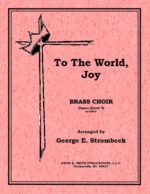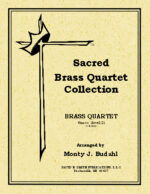-
-
-
Festival of Carols
$11.00Scored for 2 trumpets, horn, trombone, baritone and tuba this medley is a celebration of Christmas. Included are “Joy To The World,” “Angels We Have Heard On High,” “Silent Night,” and “O Come, All Ye Faithful.”
-
Two Carols
$11.00A mini suite that is based on 1) God Rest Ye Merry Gentlemen” and, 2) “We Gather Together” an Austrian carol from the 17th century.The score is solid in part management but adds motifs of punctuation to add flavor. There are optional percussion parts for those who want to add more color to the performance.
-
-
Christmas For Brass
$12.00Scored for traditional brass quintet the piece incorporates material from Pat-a-Pan with the melodic material in the upper voices and then passed to the lower voices. After much rhythmic activity the piece becomes more legato and flowing, and modulates to a new key using material from “O Come, O Ye Faithful Him,” in a fugal style After a new modulation the fragmented theme is broken into entrances by the various instruments- the tune_ “God Rest Ye Merry Gentlemen,” where it is broken into more syncopated renditions. Another modulation? Yes and this time introducing “Angels From The Realms Of Glory” The final section is imitative with brief snatches of “Joy To The World!”
-
Carol Of The Bells
$12.00A traditional quintet with optional sixth part baritone, this driving arrangement passes the melodic material constantly around the ensemble. A fun piece to play!
-
The Holly and The Ivy
$9.95Four Plus Brass Series- for two Trumpets and two Trombones (with opt. Horn and Tuba for color). Right out of the ate the first trumpet establishes the tune and the style in a vigorous manner. The middle voices then chase after each other in a gracious counterpoint. The middle section presents the tune in the trombone line while the trumpets offer an obbligato addition. With the second trombone presenting the tune the upper voices offer a rollicking accompaniment. The a modulation where the style becomes more florid it all becomes more solidified to a hold. Then, it takes off once again the a brisk ending.
-
Lo, How a Rose E’re Blooming
$9.95Four Plus Brass Series- for two Trumpets and two Trombones (with opt. Horn and Tuba for color). The introduction begins in a slow, plaintive manner leading to a gentle statement of the tune in four-part harmony while going through a series of meter changes. The section features the trombone in the theme until it once again comes to a point of repose. Then finalizes in a state of solemnity
-
Let All Mortal Flesh Keep Silent
$9.95Four Plus Brass Series- for two Trumpets and two Trombones (with opt. Horn and Tuba for color). In a slow alle breve the piece begins in a mysterious fashion in octave unisons. Leading into the section where the parts move in a two part counterpoint until it becomes more choral. Then it segues into a solemn mood with a trombone solo carrying the tune with answering sections in the trumpets. With a segment of strength and power and in a block chordal movement the piece continues to settle into solemnity until it concludes to a single pitch.
-
Good Christian Men, Rejoice
$9.95Four Plus Brass Series- for two Trumpets and two Trombones (with opt. Horn and Tuba for color). Presented in a jaunty and rollicking meter with the tune in the first trumpet. Later it is passed to the first trombone. The middle section of the work strays from the traditional tune for interest only to gravitate back to it. The final section mimics the first section and brings the piece to a final punctuation.
-
God Rest You Merry, Gentlemen
$9.95Four Plus Brass Series- for two Trumpets and two Trombones (with opt. Horn and Tuba for color). In alla breve, the style is pensive a thoughtful of mankind at peace with their situation The trumpets carry the tune throughout the whole first section until it goes into a imitative section with the trombones. After a modulation takes place the trombones carry the tune much in the same style as the trumpets, earlier. The final section becomes more relaxed where it lies in simple relation.
-
Unto Us A Child Is Born
$9.95Four Plus Brass Series- for two Trumpets and two Trombones (with opt. Horn and Tuba for color). The theme is built on the tune Puer Nabis and is in alle breve. The lines are long and solemn, primarily in the trumpets. The second section Is built in a light fughetta fabric giving interest until in breaks into a three meter with the motive passed back and forth between trumpets and trombones.The final section mirrors the open section until it bows in repose
-
Sing We Now of Christmas
$9.95Four Plus Brass Series- for two Trumpets and two Trombones (with opt. Horn and Tuba for color). The piece begins in a flowing manner- fir by the trumpets and the trombone. The next section has more contrapuntal structure heightening the emotion of the work. Various statements of these motives continue to a brief fermata, and then a more vigorous statement of the theme bringing the piece to a strong conclusion.
-
Sing Hosannas
$9.95Four Plus Brass Series- for two Trumpets and two Trombones (with opt. Horn and Tuba for color). The piece begins in a trumpet duet fashion and then echoed back in similar manner by the trombones. The next section is tossed about with bell like support motives, only to be broken down in motives and passed around the various voices. A modulation takes place and pieces like the beginning are once again presented and then back to the motive repeats bringing the piece to a strong conclusion.
-
Carols Of Cheer
$8.00A Christmas brass quartet score for two trumpets, horn and trombone with optional parts for Flugel horn (horn) and bartione (trombone) in a medley format includes “Fum Fum Fum,” “Come Here Little Children,” ” Ding Dong Merrily On High” that bubbles with delight from beginning to end. With multiple key transitions and color shifts this medley will add delight and cheer to this festive time of the year.
-
Christmas Brass Quartet Collection
$15.95(2-tp, 2-Trb, hn/BH) -four pieces: Hark The Herald Angels It Came Upon A Midnight Clear; Angels We Have Heard On High; O Little Town Of Bethlehem
-
-
Three Scenes From Bethlehem
$9.00A brass trio for trumpet, horn and trombone with opt. Trp. And baritone parts which is rather unique. The piece is a medley of “O Little Town Of Bethlehem,” “We Three Kings,” and “Joy To The World.” The piece optionally incorporates read scripture…
-
Dona Nobis Pacem
$4.50This tuba solo begins with a brief motif in the piano and then begins a series of variations and the soloist presents the theme. The variations are sometimes florid, other times plaintive, some times imitative and finally bold.
-
I Wonder As I Wander
$4.50This solo is plaintive throughout as it begins with a simple melodic motive. The first verse is simply stated in the solo while supported with broken chords in the piano. The second verse is much like the first but the piano not supports the tune with gentle punctuations. The third verse is in the piano while the solo line produces a ebb and repose obbligato- the two line join together in a dramatic cadence and then settles down to a quite repose where the piano continues in a solemn flavor. The final statement in the solo is much like the first where it is joined with moving scale patterns in the piano. The two players sweep upward one last time to then settle down into solemnity.
-
Away In A Manger
$3.50This solo with piano begins with the portrayal of a pastoral setting. The arrangement incorporates both “Flow Gently Sweet Afton” and “Luther’s Hymn”.
-
Dona Nobis Pacem
$4.50This trombone solo begins with a brief motif in the piano and then begins a series of variations and the soloist presents the theme. The variations are sometimes florid, other times plaintive, some times imitative and finally bold.
-
Hallelujah Chorus
$5.00A solo instrument with piano accompaniment? Can an arrangement capture the essence of the original with the majesty of full chorus and orchestra? This piece really does- it is amazingly complete!
-
I Wonder As I Wander
$4.50This solo is plaintive throughout as it begins with a simple melodic motive. The first verse is simply stated in the solo while supported with broken chords in the piano. The second verse is much like the first but the piano not supports the tune with gentle punctuations. The third verse is in the piano while the solo line produces a ebb and repose obbligato- the two line join together in a dramatic cadence and then settles down to a quite repose where the piano continues in a solemn flavor. The final statement in the solo is much like the first where it is joined with moving scale patterns in the piano. The two players sweep upward one last time to then settle down into solemnity.

























